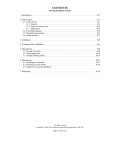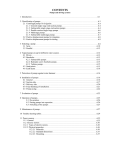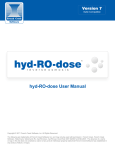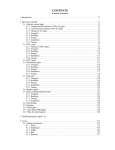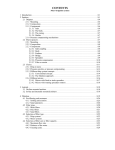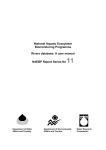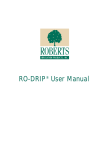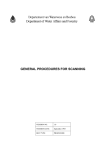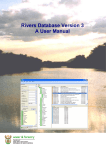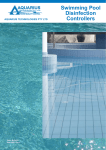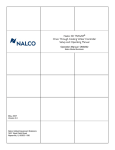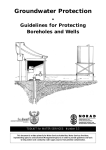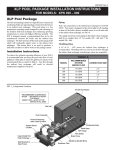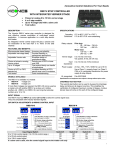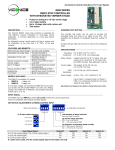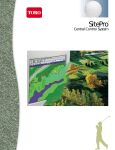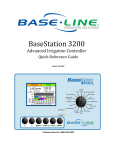Download Types of sprinkler irrigation
Transcript
CONTENTS Sprinkler irrigation systems 1 Introduction ............................................................................................................................................................................................................................................... 9.1 2 Types of sprinkler irrigation ................................................................................................................................................................................................ 9.1 3 Components used in sprinkler irrigation.................................................................................................................................................................. 9.2 3.1 Main line....................................................................................................................................................................................................................................... 9.2 3.2 Hydrant........................................................................................................................................................................................................................................... 9.3 3.3 Lateral .............................................................................................................................................................................................................................................. 9.3 3.4 Stand pipe .................................................................................................................................................................................................................................... 9.4 3.5 Flow controllers ................................................................................................................................................................................................................... 9.4 3.5.1 Flexible flow control ...................................................................................................................................................................................... 9.4 3.5.2 Spring loaded flow control ...................................................................................................................................................................... 9.6 3.6 Dragline hoses........................................................................................................................................................................................................................ 9.7 3.7 Sprinklers ..................................................................................................................................................................................................................................... 9.8 3.8 Filters ................................................................................................................................................................................................................................................ 9.9 4 Installation .................................................................................................................................................................................................................................................. 9.9 5 Evaluation after installation .............................................................................................................................................................................................. 9.10 6 Management ......................................................................................................................................................................................................................................... 9.11 7 Maintenance.......................................................................................................................................................................................................................................... 9.12 7.1 Water quality ....................................................................................................................................................................................................................... 9.13 7.2 Maintenance scheduling for sprinkler systems ............................................................................................................................ 9.14 8 Troubleshooting tables ............................................................................................................................................................................................................. 9.15 9 References............................................................................................................................................................................................................................................... 9.16 All rights reserved Copyright 2004 ARC-Institute for Agricultural Engineering (ARC-ILI) ISBN 1-919849-24-6 Sprinkler irrigation systems 9.1 1 Introduction In the sprinkler method of irrigation, water is applied above the ground surface as a spray somewhat resembling rainfall. The spray is developed by the flow of water under pressure through small orifices or nozzles. The pressure is usually obtained by pumping, although it may be by gravity if the water source is high enough above the area to be irrigated. The irrigation water is distributed to the field through pipelines. Sprinkler irrigation is adaptable to most crops, soils and topographical circumstances. However for an economical system and even water distribution over the total land surface, careful judgement of the design criteria is required. With careful selection of nozzle sizes, riser heights, operating pressure and sprinkler spacing, water can be applied uniformly at a rate lower than the infiltration rate of the soil, thereby preventing runoff and the resulting damage to land and crops. This chapter contains general information as it appears in the Irrigation Design Manual of the ARCInstitute for Agricultural Engineering. Practical information regarding the installation, operation and management of sprinkler systems is also included in this chapter. 2 Types of sprinkler irrigation The various types available are described and illustrated in Chapter 2: System choices. The sprinkler system includes the sprinkler, the stand pipe, the lateral pipe, the main line pipe and often the pumping plant. Cost will vary as a result of: • • • • • • • distance and difference in height between water source and centre of field; type of power source. i.e. diesel or electric; spacing of sprinklers; application rate; cycle time; quantity of water; and type and quality of material. The sprinkler system may be classified as permanent, semi- permanent or portable according to the make-up of the components and the way it is used. The most widely used distribution systems are: • • • • • • Portable lateral with sprinklers - moved as a whole. Semi-solid set - only sprinklers are moved. Dragline - only sprinklers and hoses are moved. Big gun - with portable supply pipe where gun and supply pipe are moved. Side-roll - moved as a whole. Permanent - solid set. 9.2 Irrigation User’s Manual 3 Components used in sprinkler irrigation The figure below illustrates various components that can be incorporated into a sprinkler irrigation system. Figure 9.1: Components of sprinkler irrigation 3.1 Main line The main line is a pipe which delivers water from the pump to the laterals. They are normally laid below ground (i.e. permanent) or laid above ground (i.e. portable) and have the largest diameter of the pipes in the system. The table below can be used as a guideline and is based on the cost of the pipes. Table 9.1: Pipe selection guideline Pipe Size [ mm] ≤ 50 50 - 150 > 150 Pipe Type Polyethylene uPVC Fibre Cement , Steel and Concrete Deviations from this may occur if you take working pressure, transport distances, installation costs and tender price into account. Sprinkler irrigation systems 9.3 3.2 Hydrant 1. Hydrant valve 2. Valve 3. Main line 4. Lateral Figure 9.2: Hydrant components A main line (supply line) is coupled to a lateral by means of a hydrant. A stopcock and pressure gauge are provided on the hydrant so that water can be delivered to the lateral at the correct pressure. Quick couplings are provided at the hydrant valves so the water can be turned off from the lateral, which can be disconnected and reconnected at a new location without stopping the pump. With permanent underground laterals, hydromatic valves are located at each sprinkler position. The sprinkler pipe is usually coupled to the nearest hydrant, to avoid unnecessarily long connection pipes between the hydrant and sprinkler pipe. It is essential to determine whether at any stage two laterals are operating simultaneously from one specific hydrant. If this is the case, a T-Piece instead of an elbow joint must be used. 3.3 Lateral The lateral is a pipe which delivers water from the main line to the sprinkler. It can either be portable or permanent, and is usually smaller in diameter if compared to the main line. Portable laterals are either aluminium or light steel pipe with plain coupling or lever-type coupling respectively. The different types of quick couple couplings are described in Chapter 7: Irrigation equipment. It is advisable to use more than one type of quick-coupling types in a system. One method of moving laterals is by hand, where the pipe is uncoupled, moved a length at a time and re-coupled. Permanent laterals are either polyethylene or uPVC pipe with draglines attached. For the sake of convenience, most farmers prefer lateral lines of a single pipe size. Some farmers prefer to use two pipe sizes which can result in a reduction in initial costs. Laterals containing more than two pipe sizes are not recommended. Pressure-reducing valves are used in laterals where the topography is undulating or too steep to restrict pressure variation in the line to within the 20% limit by the selection of practical pipe sizes or by means of hydrant valves. 9.4 Irrigation User’s Manual 3.4 Stand pipe Stand pipes are smaller diameter pipes which connect the sprinkler to the lateral or dragline hose. In a portable or semi-permanent system mainly galvanised steel stand pipes are used, while in a permanent system use is made of uPVC or polyethylene stand pipes. Stand pipes must be provided in order to remove the turbulence when the direction of flow is changed by diverting a part of the flow to an individual sprinkler. If not removed, this turbulence will carry through the nozzle and cause a premature stream break-up and a reduced diameter of coverage and thereby a poorer distribution pattern. The length of pipe needed to remove turbulence varies with sprinkler discharge. Table 9.2: Recommended minimum stand pipe length Sprinkler Discharge [ m³ / h ] Stand Pipe Length [ mm ] up to 3 150 3 - 7 225 7 - 14 300 The sprinkler should be placed at least 0,6 m above the crop. Stand pipes are normally available in the following lengths: 0,2 m; 0,5 m; 1,0 m; 1,2 m; 1,5 m; 2 m and 3 m (they can also be customised) with diameters ranging from 20 to 25 mm. 3.5 Flow controllers Due to the uneven distribution through a sprinkler system caused by field elevation differences, excessive pipe friction loss and variations in pump pressure, there is a need to control the flow. The satisfactory performance of impact-drive rotating sprinkler depends to a large extent on operating flow rate. There is no one place along the pipe where a single flow control can be installed that will handle an entire system. However, control can be exercised by having a flow control at each sprinkler head. More uniform water application can improved crop yields, reduce pumping costs and save in water and chemicals. The bodies are made of brass or moulded plastic. Flow control devices will only reduce the flow, but it will not increase a flow rate that is inadequate. Two methods of flow control are to fit either a flexible flow control device or a spring-loaded flow control to the system. 3.5.1 Flexible flow control There are two types of flexible flow controllers: • Flow control nozzle o Working - The flow control nozzle is fitted in place of the standard impact sprinkler nozzle which helps to equalize the flow rate from each sprinkler. - As the pressure increases so the flexible orifice contracts allowing the discharge to be held constant regardless of pressure fluctuations. - The available flow rate ranges from 0,30 l/s to 0,49 l/s. - The working pressure range is 14 to 56 m, with recommended operating pressure 17 to 35 m. Sprinkler irrigation systems 9.5 o Advantages - Designed for low pressure operation. - The unique teardrop shaped orifice is designed to produce the most desirable distribution pattern and droplet size at low pressure. - The single orifice design and self-flushing action minimises plugging. - Maintain flow rate accuracy of plus or minus 10% of the performance curves. - The stream diffusion improves water distribution uniformity of a sprinkler and reduces the droplet size at low pressures. - Since the stream is discharged across the orifice directly into the atmosphere, the pressure drop normally associated with flow control devices does not occur. o Disadvantages - If operated in high wind conditions the wetting pattern is distorted more easily than the standard nozzle patterns. - Do not use excessively wide sprinkler spacings, optimise at 12 m by 15 m. The wider spacing will reduce uniformity of application. - The orifice can easily block, which will change the distribution pattern of the sprinkler. - Due to the material of the device it is susceptible to wear. - The distribution pattern changes with an increase in pressure. Figure 9.3: Flow control nozzle • Flexible orifice o Working - Simple and effective in design and use. - The orifice changes shape to maintain a constant flow rate as the inlet pressure increases. - Operates on the same principal as the flow control nozzle. - The device is designed to deliver a constant volume of water from any outlet whether the pressure is 10 m or 85 m. - The controlling mechanism consists of a flexible orifice that varies it’s area inversely with the pressure so that a constant flow rate is maintained. o Advantages - The device is self-cleaning. - The device is not prone to scaling. - Response to pressure variation is instantaneous. - Flow rates are accurate within plus or minus 10% of the normal flow rate. - Considering individual flow controls, the rate will stay within 5% to 8% of the mean flow rate through the full range. 9.6 Irrigation User’s Manual o Disadvantages - The orifice can easily block, which will change the distribution pattern of the sprinkler. - Due to the material of the product it is susceptible to wear. Figure 9.4: Flexible orifice 3.5.2 Spring loaded flow control • Working o These flow controllers function by means of a regulating spring which is enclosed in a sealed chamber. The outgoing pressure acts on a diaphragm which compresses the spring and causes a throttling action on the inlet flow. o There are nine colour-coded reducers varying from 4,3 m to 35 m. o The flow rate which can be handled varies from 0,3 m³/h to 4 m³/h. • Advantages o At a pressure below the set regulation pressure, the throttling action is negligible. o Can operate at a maximum continuous pressure of 70 m but can withstand pressure surges of an extremely short duration. o By placing a reducer at the beginning of each lateral, enables the designer to set the same pressure at the beginning of each line in the system. o The allowable pressure variation can be restricted to the lateral alone and allow the use of longer and thinner pipes. • Disadvantages o Due to the material used it is susceptible to wear. o An expensive item in comparison to the flexible flow controllers. Sprinkler irrigation systems 9.7 Figure 9.5: Spring loaded flow control 3.6 Dragline hoses Figure 9.6: Dragline hose connection Dragline hoses are used where a sprinkler is connected to one end and a lateral pipe to the other end. The sprinklers can then be moved without displacing the pipeline. The pipe diameters range between 15 mm and 25 mm (inside diameter) and the length of pipe normally varies between 18 m and 45 m and is made of UV treated polyester reinforced PVC material. The most common size of pipe used is 20 mm. 3.7 Sprinklers Figure 9.7: Sprinkler components 9.8 Irrigation User’s Manual Many sprinklers on the market are sold together with technical documentation. When choosing a sprinkler the following must be taken into account: • Uniformity of water application. • Precipitation rate: Function of discharge, wetted diameter and sprinkler spacing. • Drop size distribution: Function of nozzle diameter, pressure and pressure variation. • The cost. • Back-up service Four general types of sprinklers are used: • Rotating sprinklers - agriculture • Floppy sprinklers - agriculture • Fixed nozzles attached to the pipe - horticulture. • Perforated pipe - nursery and gardens. The impact-drive rotating sprinkler is the most popular. The impact drive has a weighted springloaded drive arm to provide the force to rotate the nozzle assembly. The sprinkling stream deflects the arm sideways and the spring pulls the arm back to the nozzle assembly and into the path of the stream. As the drive arm completes each swing cycle it impacts against the nozzle assembly rotating it slightly. The advantage of the rotating sprinkler is its ability to apply water at a slower rate while using relatively large nozzle openings. Sprinklers can be divided according to pressure required: Table 9.3: Sprinkler categories Sprinklers Pressure [m] Flow rate [m³/h] Typical application Low pressure < 20 < 0,7 orchards Medium pressure 25 - 40 <3 cash crops High pressure > 40 < 50 pastures and sugar-cane High volume > 45 20 - 100 pastures and maize The constant rotational speed is very important, as a variation will mean a variation in the application uniformity. Large rotating sprinklers, operating at high pressures, are commonly referred to as big guns. The term big gun is derived from the large gun like nozzle and its ability to distribute large quantities of water over a wide area. They are normally mounted on risers, supported on a tripod or framework. Water is supplied to the sprinkler through a flexible hose. The terrain of the land to be irrigated should be reasonably smooth. Due to the high pressures, strong winds can influence the effective water distribution. These are high capacity, high pressure sprinklers, operating at pressures ranging from 40 to 80 m, with a delivery output ranging up to 70 m³/h. Sprinkler irrigation systems 9.9 3.8 Filters When using irrigation water that can block sprinklers, a filter with a mesh size of 1/3 of the smallest sprayer size must be installed. With the correct type of pre-filtering, filters are usually not necessary. 4 Installation The following general directives for the installation of a sprinkler system are recommended: • • • • • • • • • Reference points on the plan must first be identified and pegged out on the field before installation is begun. Subsurface pipelines must be laid deep enough so that they are not damaged by soil tilling practices. Subsurface pipes must be laid according to plan and installed according to the specifications of the manufacturer (see Chapter 7: Irrigation Equipment). Pipes must preferably not be laid during the middle of the day when it is hot. Backfilling of the material on the pipes must be done as soon as possible, but the joints must be left open for inspection. The joints can be covered with soil after evaluation of the system. It is advisable to place permanent markers at suitable spots on top of the soil to indicate the depth and position of the subsurface pipeline. Air valves and flush valves must be installed on the correct points as recommended on the plan. Parts that can rust must be treated with a rust-resistant paint. Hydrants must be installed out of the way and must be painted with a bright-coloured paint to prevent them from being run over. All mainlines and laterals must be flushed after installation to get rid of dirt that may have entered the pipes during installation. Pressure measuring points must be installed after each control valve at a block or hydrant so that the design operating pressure of the system can be set at those points. If there is no pressure measuring point, it is very difficult for one person to set the control valve to the correct operating pressure and to measure the pressure at the nearest sprinkler. Figure 9.8: Pressure verification at hydrant 9.10 Irrigation User’s Manual 5 Evaluation after installation To ensure that the irrigation system is installed correctly and function according to design specifications, the following basic evaluation procedure is proposed: Table 9.4: Proposed basic evaluation procedure after installation Subject / Item Measurement/Evaluation Inlet pressure of block Determine the inlet pressure of the blocks with a pressure gauge and compare with the required pressured as specified on the peak design form Measure pressure with a pressure gauge and measure the delivery in a container for at least five minutes at the four emitters on fours corners of the field. Examine system layout by measuring the distances between emitters/ laterals, as well as the position of valves with a tape measure. Compare installed pipe diameters with those on the plan. Also take note of the direction of the laterals/emitter lines. If lateral is installed in the wrong direction, then the slope of that lateral is not as per design. Compare the model/ manufacturer of the installed pump, electric motor, filter and emitters with the specifications as per design report. Compare the blocks / sprinklers that are in simultaneous operation, with the specification as suggested in design report. Emitter pressure and delivery System lay-out Equipment: model and manufacturer Schedule of blocks/ movable sprinklers in simultaneous operation General installation System capacity Examine if any leakages occur in the system Determine system flow rate by taking the reading from the flow meter/ measuring notch Action if measurements / evaluation does not conform to the design specifications Contact designer and adjust setup schedule if necessary If a pressure variation of more than 20% of the design pressure or a delivery variation of more than 10% occurs, as specified in the technical report, contact the designer. Re-install according to plan Contact designer for replacement of faulty equipment Change the blocks / sprinklers that are in simultaneous operation, by either opening the correct valves or reprogramming the irrigation computer. Repair leaks If a flow rate deviation of more than 10% from the average occurs, as specified in the peak design form, contact the designer. Sprinkler irrigation systems 9.11 Figure 33: Pressure measurement with a pitot tube and pressure gauge 6 Management The system must be irrigated at the design pressure else there will be an uneven distribution of water. A too low sprinkler pressure does not break up the waterjet thoroughly and the so-called doughnut effect with a poor distribution is obtained. With a too high pressure the waterjet is broken up too fine with a mist effect that can cause great losses. It was found in practice that the optimal operating pressure (kPa) of the sprinkler is between 60 and 70 times the nozzle diameter (mm). This is applicable to nozzles of 3 to 7 mm diameter (Table 9.5). Table 9.5: Optimal operating pressure vs nozzle diameter for sprinklers Nozzle diameter mm 1,59 1,98 2,38 2,78 3,18 3,57 3,97 4,37 4,76 5,16 5,56 5,95 6,35 Operating pressure (kPa) inches 1 /16 5 /64 3 /32 7 /64 1 /8 9 /64 5 /32 11 /64 3 /16 13 /64 7 /32 15 /64 1 /4 x60 x70 191 214 238 262 286 310 333 357 381 222 250 278 306 333 361 389 427 445 9.12 Irrigation User’s Manual When the wind speed reaches more than 16 km/h, the effectiveness of the system becomes inefficient and it is better to stop irrigating. Water that sprays too high into the air is more affected by wind. A nozzle that sprays 32° from the horizontal obtains the maximum sprinkler distance. Night irrigation is much more effective than daytime irrigation because of evaporation. If it suits the soil and the crop, it is best to have set-ups of 11 hours with 1 hour moving time, i.e. sprinklers are only moved mornings and evenings. The water distribution on the field should be tested once a year by setting up rain meters according to the procedure prescribed in the Irrigation Evaluation Manual of the ARC-Institute for Agricultural Engineering. System capacity and pressure must also be determined once a year as described in Table 9.4. 7 Maintenance Observation of wear on sprinkler nozzles is measured with a specially machined apparatus (Figure 9.10). The measurement shows the amount of wear (mm) on the sprinkler nozzle. If the wear is more than 5%, the nozzles must be replaced. An increase of 5% in nozzle area means a 10% increase in delivery and power demand that means additional operating cost and over-irrigating. Measurements can be done when the system is in operation or when switched off. Figure 9.10: Measuring apparatus for sprinkler nozzle size If a nozzle without a flow guide gets blocked, it can be cleaned with a piece of wire. A sprinkler nozzle with a flow guide must be cleaned carefully (not with wire). 7.1 Water quality Different indexes are used to identify whether the irrigation water is corrosive or will form a deposit. A single index can create a false impression and it is recommended that as many indexes as possible be used to evaluate the water quality. Tables 9.6 to 9.8 can be used to evaluate the effect of the water on irrigation equipment. Sprinkler irrigation systems 9.13 Tabel 9.6: Langelier-index (DWAF, 1996) Langelier-index Effect on irrigation equipment < -0,2 Increasing problems with corrosion No major problem with either corrosion or scaling of irrigation equipment -0,2 to +0,2 > +0,2 Increasing problems with scaling Tabel 9.7: Ryznar-index (DWAF, 1996) Ryznar-index Effect on irrigation systems < 6,5 Scale-forming tendency > 6,5 Corrosive tendency Tabel 9.8: Corrosion-index (DWAF, 1996) Corrosion-index Effect on irrigation systems < 0,1 No major problem with corrosion ≥ 0,1 Increasing problems with corrosion If the water analysis indicates that the water is corrosive, pipes manufactured from alternative materials – or other irrigation systems – must be considered. 7.2 Maintenance schedules for sprinkler systems The following maintenance schedule is suggested: Table 9.9: Maintenance schedule for sprinkler irrigation systems (manual control)*: Monitor With each cycle Annually Inspect the system for leakages X Check system pressure and system flow X Service air valves and hydrants X Check sprinklers for wear and replace springs, X washers and nozzles where necessary Flush mainlines X Replace rubbers at quick coupling pipes where X necessary *The suggested maintenance schedule can be adapted for automatic permanent systems, e.g. system pressure can be monitored monthly. 9.14 Irrigation User’s Manual After the irrigation season, before the pipes are stored, the following must be done: • • • • • • • Mark all the holes in quick coupling pipes with paint so that they can be repaired. Remove all gasket from pipes if they are stored in the sun. Replace all damaged and hardened gaskets. Replace all worn male and female pipe fittings. Replace all dragline pipes that have more than three joints. Check standing pipes for corrosion and replace if necessary. Ensure that all standing pipes are the same length and straight. Figure 9.11: Leakages on draglines 8 Troubleshooting tables Table 9.10: Troubleshooting table for static and movable systems Problem Emitter pressure incorrect Pump pressure incorrect Sprinkler discharge incorrect Possible causes Distribution system incorrectly designed System not installed according to plan, or additions have been made Sprinkler nozzle worn or incorrect nozzle sizes installed Leakages Too many emitters Leaks in supply systems Proposed solution Do complete evaluation of distribution system as described in Evaluation Manual Compare existing layout to layout on plan, enquire whether producer has added on or increased emitters and look for signs thereof in field Do evaluation as described in Section 5 and compare nozzle sizes with them specified in design report. Repair leaks Change system set-up Repair leaks Wrong nozzle sizes Sprinkler pressure incorrect Replace spinklers See causes/solutions above Sprinkler irrigation systems 9.15 9 References 1. De Beer, H. 2002. Prevent corrosion of centre pivots. SA Irrigation. December/January. RSA. 2. DWAF. 1996. South African Water Quality Guidelines Volume 4 Agricultural Use: Irrigation. RSA. 3. Scott, K. 2002. Personal communication. ARC-Institute for Agricultural Engineering. Pretoria, RSA. 4. Viljoen, P. D., Mulder, D. J., Burger, J. H., Heyns, P. J., Kleynhans, E. P. J., Koegelenberg, F. H., Lategan, M. T., Smal, H. S., Stimie, C. M., Uys, W. J. and Van der Merwe, F. P. J. 1996. Irrigation Design Manual. ARC-Institute for Ahricultural Engineering. RSA.

















